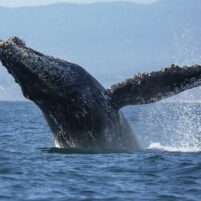Researchers spot whales near California wind farm zones
December 21, 2022
 By JOSH FRIEDMAN
By JOSH FRIEDMAN
Researchers have spotted whales around areas off the coasts of California and Oregon that may become offshore wind farm zones.
Last year, the federal Department of the Interior, in coordination with the Department of Defense, identified a 399-square-mile area northwest of Morro Bay as a location that will support three gigawatts of offshore wind. The federal agency also announced it was advancing wind energy projects located offshore of Humboldt County.
Then earlier this month, the federal government auctioned five offshore areas for wind development, three of which are northwest of Morro Bay and two of which are off of Humboldt County. The auction of the leases netted a combined total of $757 million.
Additionally, the Bureau of Ocean Energy Management (BOEM) is considering auctioning off a pair of leases for zones off the coast of Oregon.
The BOEM has identified the risk of whale entanglements in floating platform moorings and cabling as a concern related to the wind energy projects.
The federal government has commissioned Oregon State University researchers to examine possible impacts of offshore wind farms on marine life. The researchers are conducting a four-year study documenting sea birds, whales and dolphins around areas put up for leases for offshore wind farm development.
Participants in the study have already spotted endangered whales while out on research cruises.
“There are quite a lot of large whales out there, quite a number,” said Lisa Ballance, the director of Oregon State’s Marine Mammal Institute and the principal investigator on the project. “Humpbacks are quite abundant. Increasingly, blue whales are quite abundant. We also see a whale that is less familiar to most people called a sei whale. It looks a lot like a blue whale, not quite as big but a very large animal.”
Blue whales, sei whales and some sub-populations of humpbacks are federally-listed as endangered species. As for birds, researchers have spotted threatened marble murrelets, as well as long-distance travelers like black-footed albatrosses and Laysan albatrosses.
Researchers need to do a lot more analysis before determining whether anchoring large floating wind turbines in the proposed waters would create problems for marine life, Ballance said.






The comments below represent the opinion of the writer and do not represent the views or policies of CalCoastNews.com. Please address the Policies, events and arguments, not the person. Constructive debate is good; mockery, taunting, and name calling is not. Comment Guidelines